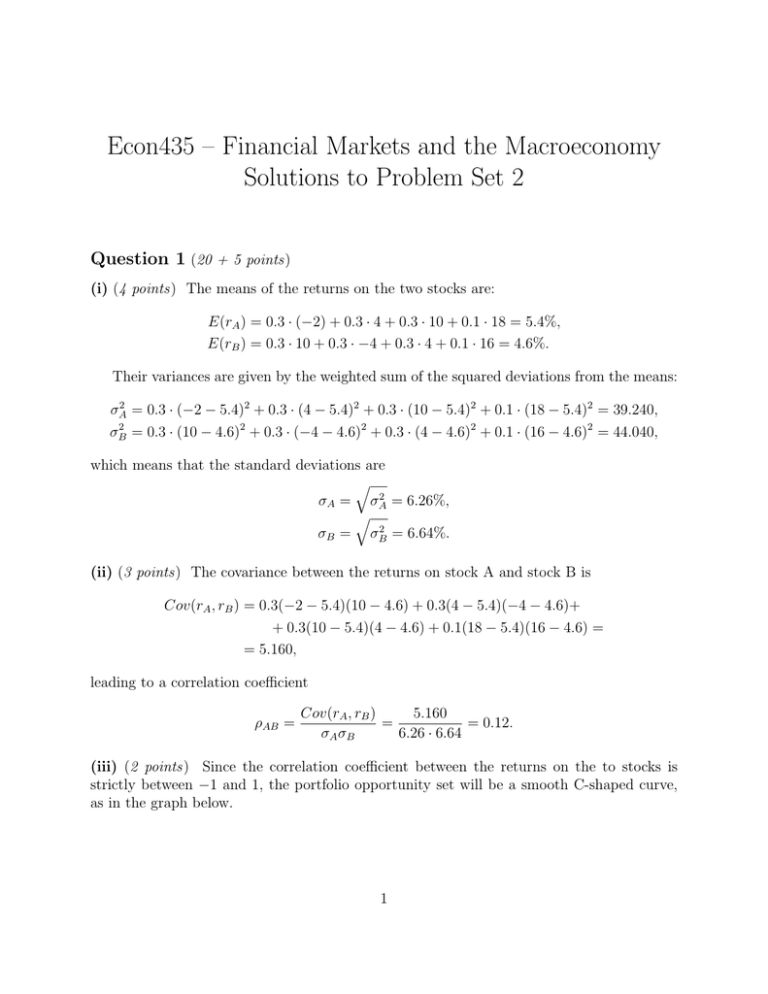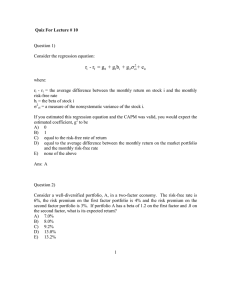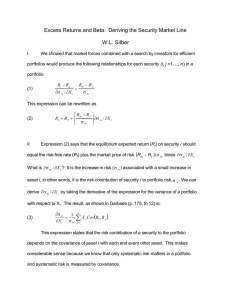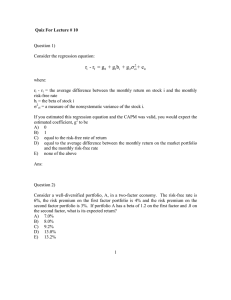Econ435 – Financial Markets and the
advertisement

Econ435 – Financial Markets and the Macroeconomy Solutions to Problem Set 2 Question 1 (20 + 5 points) (i) (4 points) The means of the returns on the two stocks are: E(rA ) = 0.3 · (−2) + 0.3 · 4 + 0.3 · 10 + 0.1 · 18 = 5.4%, E(rB ) = 0.3 · 10 + 0.3 · −4 + 0.3 · 4 + 0.1 · 16 = 4.6%. Their variances are given by the weighted sum of the squared deviations from the means: σA2 = 0.3 · (−2 − 5.4)2 + 0.3 · (4 − 5.4)2 + 0.3 · (10 − 5.4)2 + 0.1 · (18 − 5.4)2 = 39.240, σB2 = 0.3 · (10 − 4.6)2 + 0.3 · (−4 − 4.6)2 + 0.3 · (4 − 4.6)2 + 0.1 · (16 − 4.6)2 = 44.040, which means that the standard deviations are q σA = σA2 = 6.26%, q σB = σB2 = 6.64%. (ii) (3 points) The covariance between the returns on stock A and stock B is Cov(rA , rB ) = 0.3(−2 − 5.4)(10 − 4.6) + 0.3(4 − 5.4)(−4 − 4.6)+ + 0.3(10 − 5.4)(4 − 4.6) + 0.1(18 − 5.4)(16 − 4.6) = = 5.160, leading to a correlation coefficient ρAB = Cov(rA , rB ) 5.160 = = 0.12. σA σB 6.26 · 6.64 (iii) (2 points) Since the correlation coefficient between the returns on the to stocks is strictly between −1 and 1, the portfolio opportunity set will be a smooth C-shaped curve, as in the graph below. 1 Figure 1: Portfolio Opportunity Set. (iv) (8 points) In order to calculate the optimal proportions to be invested in the risky portfolio and in the risk-free free asset, we first need to find the mean and variance of the risky portfolio. They are: E(rp ) = wA E(rA ) + wB E(rB ) = 0.78 · 5.4% + 0.22 · 4.6% = 5.22%, 2 2 2 2 σp2 = wA σA + wB σB + 2wA wB Cov(rA , rB ) = 0.782 · 39.240 + 0.222 · 44.040 + 2 · 0.78 · 0.22 · 5.160 = 27.78, q σp = σp2 = 5.27%. Note that by combining stock A and stock B, investor X obtained a portfolio with lower risk than both A and B, but with a higher return than stock B. Using this information, we can now calculate the optimal proportion to be invested in the risky portfolio: y∗ = E(rp ) − rf 5.22 − 4 = = 0.73. 2 0.01Aσp 0.01 · 6 · 27.78 2 The proportion to be invested in the risk-free asset is 1 − y ∗ = 0.27. This enables us to calculate the mean, variance and standard deviation of the complete portfolio: E(rC ) = y ∗ E(rp ) + (1 − y ∗ )rf = 0.73 · 5.22% + 0.27 · 4% = 4.9%, σC2 = y ∗2 σp2 = 0.732 · 27.78 = 14.98, q σC = σC2 = 3.87%. Graphically, we can represent this as in the next figure. Figure 2: Optimal Complete Portfolio. (v) (3 points) If the borrowing rate is higher than the lending rate, then the CAL would have a “kink” like in the graph below (either of the explanations was considered correct). Since investor X is not a borrower, the optimal complete portfolio would not change. It would still lie on the “original” Capital Allocation Line and would not be affected by the higher borrowing interest rate. (vi) (extra credit – 5 points) Any rational investor will choose the risk-free asset with the highest rate of return. Again, it is important that investor X is not a borrower. In this case, the original risk-free rate offers the highest rate of return (as compared to the new risk-free 3 Figure 3: Optimal Complete Portfolio with Higher Borrowing Rate. asset). Hence, investor X will choose the same risk-free asset and thus end up with the same optimal complete portfolio as before. In conclusion, nothing changes. The situation would be different if investor X were a borrower. In this case, the new risk-free asset brings a lower interest on borrowing, and thus the investor would prefer it to the original risk-free asset. The optimal complete portfolio would change (you would need to redo the calculations in part iv, using the new risk-free rate instead of the old one) and investor X would end up borrowing even more. 4




